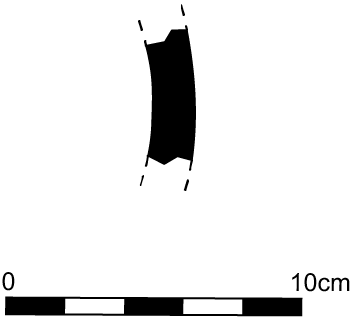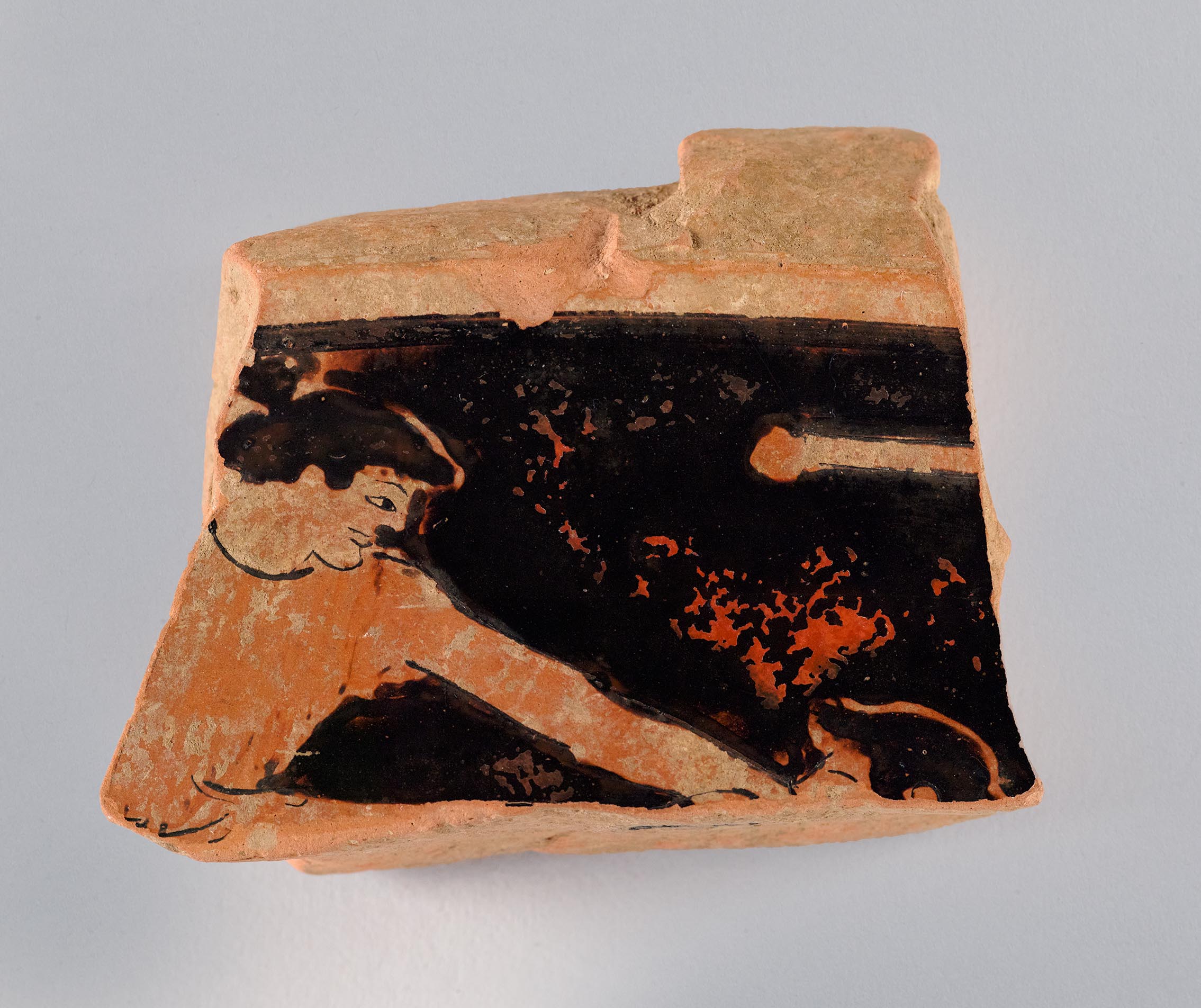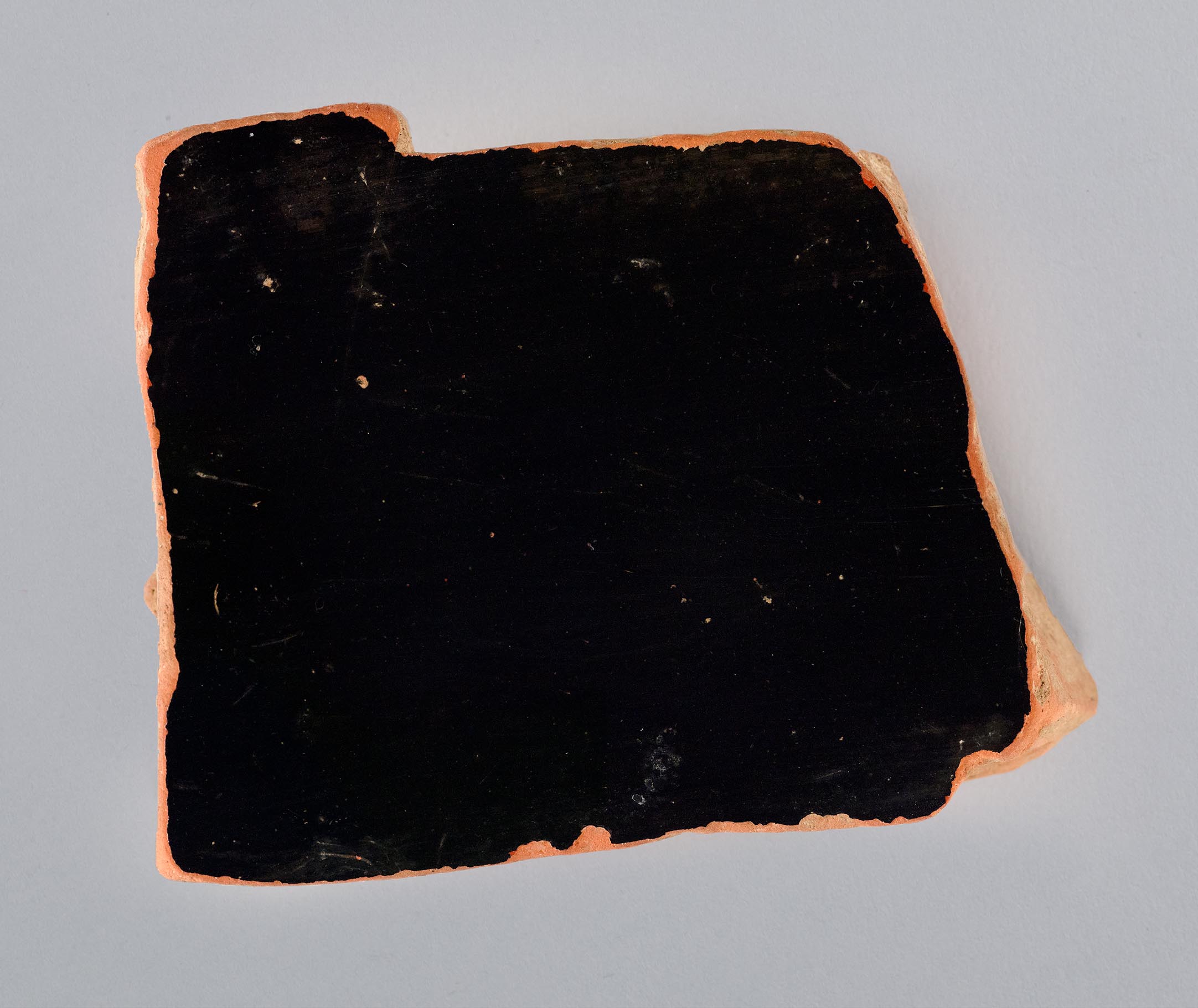Provenance
1987, gift, Mr. and Mrs. Elie Borowski (Toronto) to Princeton University.
Shape and Ornament
Single fragment from the slightly concave upper register of the neck. Reserved groove above the figural scene and below the fractured lip. Interior black. No ornament preserved.

Subject
One of the deeds of Theseus. Theseus attacks from the left, extending his left arm diagonally down toward a fallen adversary. His head and most of his torso are preserved. The hero wears a chitoniskos, and his long hair is pulled up and back in a krobylos knot. The top of his opponent’s head and the upper contour of his right arm and hand, which reaches toward Theseus’s midriff, are preserved. Both figures wear white fillets, now worn. At the upper right is the lower end of what may be a suspended scabbard.
Attribution and Date
Attributed to the Eucharides Painter [J. R. Guy]. Circa 500–480 BCE.
Dimensions and Condition
4.4 × 5.5 cm; thickness 1.3 cm. Broken on all sides. Figural decoration worn. Black gloss flaked in places, in particular around the falling adversary’s head and the chape of the scabbard.
Technical Features
Relief contours: scabbard; arms of both figures; nose of Theseus’s adversary. Accessory color. White: fillets, largely effaced. Dilute gloss: folds of Theseus’s chitoniskos.
Bibliography
Abbreviation: Princeton RecordRecord of the Princeton University Art Museum. (1942– ). 47 (1988): 47 [not illus.]; E. Langridge, “The Eucharides Painter and His Place in the Athenian Potters Quarter” (PhD diss., Princeton University, 1993), 448, no. K4 (attributed to the Karkinos Painter); Abbreviation: Gaunt, “Attic Volute-Krater”J. Gaunt. “The Attic Volute-Krater.” Ph.D. diss., Institute of Fine Arts, New York University, 2002, 538, no. V.73.
Comparanda
For the Eucharides Painter, see Abbreviation: ABVJ. D. Beazley. Attic Black-Figure Vase-Painters. Oxford, 1956 295–98; Abbreviation: ARV2J. D. Beazley. Attic Red-Figure Vase-Painters. 2nd ed. Oxford, 1963 226–32, 1637, 1705; Abbreviation: ParalipomenaJ. D. Beazley. Paralipomena: Additions to Attic Black-Figure Vase-Painters and to Attic Red-Figure Vase-Painters. Oxford, 1971 173–74, 347–48; Abbreviation: BAdd2Carpenter, T. H., ed. 1989. Beazley Addenda: Additional References to ABV, ARV2, and Paralipomena. 2nd ed. Oxford: Published for the British Academy by Oxford University Press. 199–200; J. D. Beazley, “The Master of the Eucharides-Stamnos in Copenhagen,” Abbreviation: BSABritish School at Athens Annual 18 (1911–12): 217–33; H. Hoffmann, “Eine neue Amphora des Eucharidesmalers,” Jahrbuch der Hamburger Kunstsammlungen 12 (1967): 9–34; K. P. Stähler, Eine unbekannte Pelike des Eucharidesmalers im Archaologischen Museum der Universitat Münster (Cologne, 1967); Langridge, “Eucharides Painter.” Langridge attributed the Princeton fragment to the Karkinos Painter, but Guy’s attribution to the Eucharides Painter is better supported. Although the Eucharides Painter often drew eyes that open at the inner corner, such eyes are largely confined to his larger figures, whereas figures appearing on the necks of amphorae or volute-kraters are instead closed and almond-shaped, like those of the Nikoxenos and Karkinos Painters, but noticeably smaller, as on Princeton’s fragment: cf. Hamburg 1966.34 (Abbreviation: ParalipomenaJ. D. Beazley. Paralipomena: Additions to Attic Black-Figure Vase-Painters and to Attic Red-Figure Vase-Painters. Oxford, 1971 347.8 ter; Abbreviation: BAPDBeazley Archive Pottery Database. http://www.beazley.ox.ac.uk 352495); Corinth KP 1156 (Abbreviation: ARV2J. D. Beazley. Attic Red-Figure Vase-Painters. 2nd ed. Oxford, 1963 1637.20 ter; Abbreviation: BAPDBeazley Archive Pottery Database. http://www.beazley.ox.ac.uk 275119). Other elements pointing to the Eucharides Painter are the strong protruding chin of Theseus and his high arched eyebrow. For a recent discussion of the Nikoxenos-Eucharides Workshop, see Abbreviation: Williams, “Workshop View”Williams, D. 2017. “Beyond the Berlin Painter: Toward a Workshop View.” In Padgett, Berlin Painter, 144–88. 160–62. See also Abbreviation: Robertson, Art of Vase-PaintingM. Robertson, The Art of Vase-Painting in Classical Athens. Cambridge, 1992, 118–21; J. M. Padgett, “The Workshop of the Syleus Sequence: A Wider Circle,” in Abbreviation: Athenian Potters and PaintersAthenian Potters and Painters: The Conference Proceedings. 3 vols. Vol. 1, edited by J. H. Oakley, W. D. E. Coulson, and O. Palagia. Oxbow Monograph 67. Vol. 2, edited by J. H. Oakley and O. Palagia. Vol. 3, edited by J. H. Oakley. Oxford, 1997 (vol. 1), 2009 (vol. 2), 2014 (vol. 3), vol. 1, 213–30.
For volute-kraters from the Nikoxenos-Eucharides Workshop, see Abbreviation: Gaunt, “Attic Volute-Krater”J. Gaunt. “The Attic Volute-Krater.” Ph.D. diss., Institute of Fine Arts, New York University, 2002, 201–13. For some forty years after the François Vase of Kleitias (Florence 4209: Abbreviation: ABVJ. D. Beazley. Attic Black-Figure Vase-Painters. Oxford, 1956 76.1; Abbreviation: BAPDBeazley Archive Pottery Database. http://www.beazley.ox.ac.uk 300000), the figural decoration on Attic volute-kraters was confined to the neck. This practice continued occasionally, even after Euphronios reintroduced figural decoration on the body with his volute-krater in Arezzo (inv. 1465; Abbreviation: ARV2J. D. Beazley. Attic Red-Figure Vase-Painters. 2nd ed. Oxford, 1963 15.6, 1619; Abbreviation: BAPDBeazley Archive Pottery Database. http://www.beazley.ox.ac.uk 200068). It is not possible to say whether the fragment in Princeton was from a vase that also had a decorated body, or, indeed, whether the lower register of the neck was also painted with figures or florals. The Nikoxenos Painter and his followers the Eucharides and Karkinos Painters all decorated the necks of their volute-kraters in one of two ways: either with florals on the upper neck and figures on the lower neck, or with figures above a black lower register (see Abbreviation: Gaunt, “Attic Volute-Krater”J. Gaunt. “The Attic Volute-Krater.” Ph.D. diss., Institute of Fine Arts, New York University, 2002, 201–13). Given that Princeton’s fragment came from the upper register of the neck, it is likely that the lower register would have been black. The placement of figural decoration on both registers is in general rather rare. Cf., by the Copenhagen Painter, a roughly contemporary volute-krater, which shows the cycle of Theseus’s deeds on the neck, on loan from the Fondation Morat to the Archaeological Collection of the University of Freiburg (Sotheby’s, Antiquities, auc. cat., July 8, 1993, London, lot 261; J. Neils, The Youthful Deeds of Theseus [Rome 1987], 156, no. 26; Abbreviation: BAPDBeazley Archive Pottery Database. http://www.beazley.ox.ac.uk 44988).
For the iconography of Theseus and his cycle of deeds on his journey to Athens, see Neils, Youthful Deeds; H. A. Shapiro, “Theseus: Aspects of the Hero in Archaic Greece,” in New Perspectives in Early Greek Art, ed. D. M. Buitron (Washington, DC, 1991), 123–39; J. Neils, in Abbreviation: LIMCLexicon Iconographicum Mythologiae Classicae. 1981–2009 7 (1994), 925–34, pls. 623–50, nos. 32–154, s.v. “Theseus”; E. A. Bartlett, “The Iconography of the Athenian Hero in Late Archaic Greek Vase-Painting” (PhD diss., University of Virginia, 2015), 87–136. Even though the fragment lacks clear attributes to aid in the identification of the figures, the composition of the scene, with a beardless man grabbing the face or beard of a falling adversary, who reaches out in supplication, is reminiscent of the deeds of Theseus. In confrontations with Prokrustes, Theseus often reaches toward his opponent’s face with a bare hand: cf. Munich SH 2325 (Abbreviation: ARV2J. D. Beazley. Attic Red-Figure Vase-Painters. 2nd ed. Oxford, 1963 530.19, 1561; Abbreviation: BAPDBeazley Archive Pottery Database. http://www.beazley.ox.ac.uk 205995); Vienna 321 A (Abbreviation: ARV2J. D. Beazley. Attic Red-Figure Vase-Painters. 2nd ed. Oxford, 1963 592.35; Abbreviation: BAPDBeazley Archive Pottery Database. http://www.beazley.ox.ac.uk 206858). Princeton’s fragment does not preserve any trace of a rock, tree, or bed, which are often the only elements that can distinguish Theseus’s consistently bearded and nude adversaries. Both Skiron, whom Theseus defeated by tossing over a cliff with his bare hands, and Prokrustes are often depicted with rocks in the landscape, leaving the shape of the rock and the weapon used by Theseus as the only distinguishing elements. For an analysis of the landscape elements in the myth of Theseus, see N. Dietrich, Figure ohne Raum? Bäume und Felsen in der attischen Vasenmalerei des 6. und 5. Jahrhunderts v. Chr. (Berlin, 2010), 311–458. The weapon that Theseus uses to strike down his foe can also be attributive, such as an axe used to cut down Prokrustes, but no trace of such a weapon is preserved. The compositions can be very similar otherwise, with Theseus once again reaching out a bare hand toward the face of Skiron: cf., inter alia, Berlin 1984.61 (CVA Berlin 8 [Germany 62], 19–20, pl. 6.1–6; Abbreviation: BAPDBeazley Archive Pottery Database. http://www.beazley.ox.ac.uk 44057). More often, however, Theseus grabs with both hands the lower feet or body of Skiron, who frequently turns away from the hero and is shown falling off the cliff: cf. Florence 3985 (Abbreviation: ARV2J. D. Beazley. Attic Red-Figure Vase-Painters. 2nd ed. Oxford, 1963 204.110; Abbreviation: BAPDBeazley Archive Pottery Database. http://www.beazley.ox.ac.uk 201918). It is therefore more likely that Princeton’s fragment presents Theseus’s encounter with Prokrustes. The object above the falling adversary seems to be a scabbard, which often appears hanging in the background of Theseus’s duels, perhaps an allusion to the sword that Aegeus left under the stone as a sign of his son’s birthright: cf. Athens 1666 (Abbreviation: ARV2J. D. Beazley. Attic Red-Figure Vase-Painters. 2nd ed. Oxford, 1963 1567.13; Abbreviation: BAPDBeazley Archive Pottery Database. http://www.beazley.ox.ac.uk 350911); London E 441 (Abbreviation: ARV2J. D. Beazley. Attic Red-Figure Vase-Painters. 2nd ed. Oxford, 1963 187.57; Abbreviation: BAPDBeazley Archive Pottery Database. http://www.beazley.ox.ac.uk 201709). Alternatively, the hanging scabbard could signify that Theseus uses a different weapon to slay his adversary, presumably the axe of Prokrustes.
The youthful deeds of Theseus seldom occur on the necks of volute-kraters and are not favored in general by Late Archaic painters of large pots. It is possible that Princeton’s fragment is part of a larger cycle of the deeds of Theseus circling the neck, as on the volute-krater in Freiburg (supra). It is also possible, however, that the painter represented only an isolated deed of Theseus: cf. another roughly contemporary, unattributed volute-krater, once in the Basel art market (Neils, Youthful Deeds, 154, no. 8, fig. 25); an unattributed volute-krater fragment in Athens, Athens, Agora P 25978 (Neils, Youthful Deeds, 154, no. 9; Abbreviation: BAPDBeazley Archive Pottery Database. http://www.beazley.ox.ac.uk 44060); and a volute-krater in Syracuse attributed to the Tyszkiewicz Painter, Syracuse 9318 (Abbreviation: ARV2J. D. Beazley. Attic Red-Figure Vase-Painters. 2nd ed. Oxford, 1963 290.3; Neils, Youthful Deeds, 160, no. 51; Abbreviation: BAPDBeazley Archive Pottery Database. http://www.beazley.ox.ac.uk 202633).
Only one work attributed to the Karkinos Painter shows Theseus: New York 59.11.20 (supra), with Theseus’s abduction of Antiope. Moore (M. B. Moore, Attic Red-Figured and White-Ground Pottery, Abbreviation: AgoraAthenian Agora (Princeton 1953– ) 30 [Princeton, NJ, 1997], 169–70, no. 234) connected Athens, Agora P 25978 (supra), which portrays Theseus and the bull, with the Nikoxenos Painter and his workshop, while Gaunt discusses the fragment in connection with the Karkinos Painter (Abbreviation: Gaunt, “Attic Volute-Krater”J. Gaunt. “The Attic Volute-Krater.” Ph.D. diss., Institute of Fine Arts, New York University, 2002, 209). The drawing is not as careful as on other vases attributed to the Nikoxenos and Karkinos Painters. Furthermore, the krater does not follow the organization of decoration found in the work of the Nikoxenos, Eucharides, and Karkinos Painters, as it features florals on the lower register below the figural decoration. No vases attributed to the Eucharides Painter show the deeds of Theseus, while only one attributed to the Nikoxenos Painter depicts Theseus: a column-krater, with Theseus and the bull, once in the New York art market (K. Schauenberg, “Zu einem spätarchaischen Kolonettenkrater in Lugano,” Abbreviation: NumAntClNumismatica e antichità classiche: Quaderni ticinesi 11 [1982]: 27, figs. 27–29; Abbreviation: BAPDBeazley Archive Pottery Database. http://www.beazley.ox.ac.uk 9588). While Theseus garnered little interest from either the Eucharides or Karkinos Painters, the hero’s youthful deeds were popular in the work of the Kleophrades Painter, more so than any other artist of the period (Neils, Youthful Deeds, 64–73). Langridge (“Eucharides Painter,” 85–90) concluded that the Kleophrades Painter had a profound impact on both the Eucharides Painter and the Karkinos Painter, and to Gaunt (Abbreviation: Gaunt, “Attic Volute-Krater”J. Gaunt. “The Attic Volute-Krater.” Ph.D. diss., Institute of Fine Arts, New York University, 2002, 204), the Princeton fragment recalled a portion of a volute-krater neck attributed by Guy to the Kleophrades Painter: Gravisca 72/3402 (K. Huber, Gravisca: Le ceramiche attiche a figure rosse [Bari, 1999], 128, no. 684). Consequently, the Princeton fragment may show the influence of the Kleophrades Painter in the early days of the workshop, before the Karkinos, Nikoxenos, and Eucharides Painters pursued other subjects.

